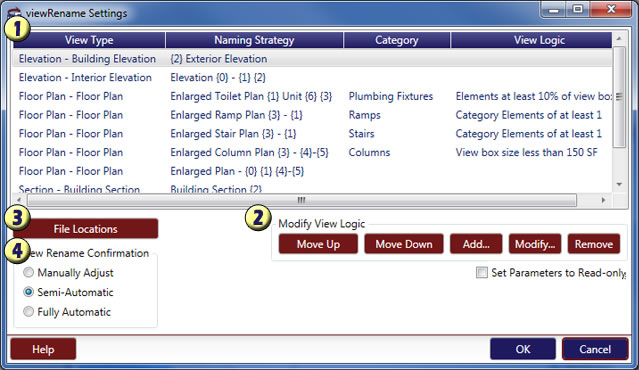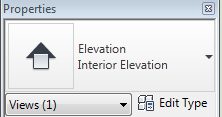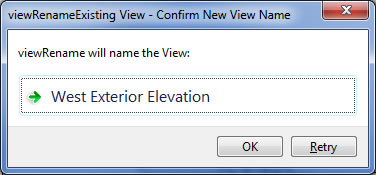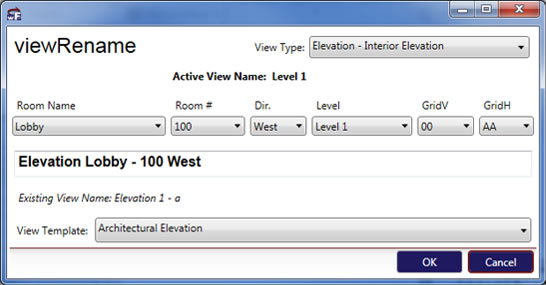viewRename
![]() Click the icon for a Video Example (requires internet connection)
Click the icon for a Video Example (requires internet connection)
viewRename is an addin that allows the user to define a view naming standard and automatically name views based on the standard.
viewRename Settings
The viewRename settings dialog consists of four primary regions:

- View Types / Rename default / View Template / Category / View Logic – These settings are the primary way you will
set up your company view naming standard, so it has been made as customizable as possible.
 The View Type relates to the name that you see in the properties box when you select the view. If you have Revit users that tend to duplicate and add new view types, just ask them to add text to the end of the view type name so that viewRename will still understand how to handle this view type.
The View Type relates to the name that you see in the properties box when you select the view. If you have Revit users that tend to duplicate and add new view types, just ask them to add text to the end of the view type name so that viewRename will still understand how to handle this view type.
Naming Strategy is the text that is a bit cryptic but defines the structure of view name. In order to modify these View Parameters, you will need to select the Modify View Logic group and Add or Modify a specific View.
Category is related to the View Logic field and is used to differentiate similar view types. When you create a callout view, sometimes you would like it to rename the view depending on what objects exist in the room (for example: Enlarged Stair plan). Use this field in combination with View Logic to assign as specific name to a view.
The View Logic field controls many aspects of how viewRename selects the correct View Type. Below is a quick description of each option:
- Elements at least 10% of view box – using the Category field, this option will be selected if 10% or more of the callout area is filled with elements of that category.
- Elements at least 50% of view box – using the Category field, this option will be selected if 50% or more of the callout area is filled with elements of that category.
- Category Elements of at least 1 – using the Category field, this option is selected if at least 1 element of that category is present in the view.
- Category Elements total 5 of more – using the Category field, this option is selected if at least 5 elements of that category are present in the view.
- View box size less than 150 SF – this logic simply sizes the callout area for the view and determines if it is less than 150 SF.
- View box size larger than 150 SF – this logic simply sizes the callout area for the view and determines if it is larger than 150 SF.
- Active View type – Section – the default active view for viewRename is a floor plan but occasionally you will draw a callout view inside a section view and this logic will allow the program to determine how to handle the naming.
- Active View type – Elevation – the default active view for viewRename is a floor plan but occasionally you will draw a callout view inside an elevation view and this logic will allow the program to determine how to handle the naming.
- The Modify View Logic group is used to add/modify/remove or change the order of View Parameters. Keep in mind that the add-in will start at the top of the list and move down until it finds the View Logic or View Type that match correctly.
Set Parameters to Read-only – This checkbox is just another safe guard to prevent users at a firm from modifying the parameter list (to maintain the company standard). If the File Locations are set to a central settings file on the server, the parameter list will change dynamically as company standards change.- In addition to the four Parameters already described, the View Template field is available if you would like to assign a specific view template to a view. Many firms have their own view template strategy and this can be quite helpful for keeping views consistent in appearance. If you have no view template that you would like to default the view to just select <Existing> and it won’t affect the view template.
- View Legend – There are the 7 dynamic options driven from the model components that you may use in the view name structure. Below is a description of each option:
- In addition to the four Parameters already described, the View Template field is available if you would like to assign a specific view template to a view. Many firms have their own view template strategy and this can be quite helpful for keeping views consistent in appearance. If you have no view template that you would like to default the view to just select <Existing> and it won’t affect the view template.
- {0} = Room Name – As expected, this is the room name from the room that is closest to the view you are renaming.
- {1} = Room Number – this is the room number from the room that is closest to the view you are renaming.
- {2} = Direction – this option has different results depending on what type of view you are using it on. For an elevation on a floor plan, you will obviously get the direction the view is pointing (North, East, South, or West). For a building elevation view, the directions are flipped because of how we typically associate exterior elevations. With a section view on a floor plan, the direction will refer to the side of the building being cut (Example: North wall).
- {3} = Level – As expected, this is the level closest to the view you are renaming.
- {4} = Grid Horiz. – this option finds the grid line that is closest to the view you are renaming that is running horizontal to the view.
- {5} = Grid Vert. – this option finds the grid line that is closest to the view you are renaming that is running vertical to the view.
- {6} = Active Viewname – occasionally you will need to designate a view by what Unit or Building it is located in (as an example). To do this, simply choose a Keyword and Modification (explained in the next paragraph).
Modification / Keyword – These fields are used to modify the information as follows:- lowercase – as the name suggests, this turns everything lowercase.
- UPPERCASE – as the name suggests again, this turns everything uppercase.
- Abbreviated – this modification is a bit limited at the moment, if you would rather label your Level as “Lvl” you can choose this.
- Use word before – this is designed to work with Active Viewname for the most part and requires a Keyword. It will filter and use the word before the Keyword.
- Use word after – this is designed to work with Active Viewname for the most part and requires a Keyword. It will filter and use the word after the Keyword.
- Unchanged – As the name suggests, it will leave the text unchanged.
For example, {0} becomes the room name and {1} becomes the room number as it relates to the location of the view.
- File Locations - Unless you are working primarily from your own computer only, you will want to set up a central version of the viewRename settings file on your company server. Each user has their own XML settings file locally for viewRename and this allows you a bit of flexibility.
- View Rename Confirmation – This is new with version 3.0, allowing you to skip a step or two when custom modifications to the view name are unnecessary. Previously, the setting was Manually Adjust allowing you to verify all of the view properties before changing the view name. Now, you can select from Se
 mi-Automatic or Fully Automatic depending on your level of comfort with the program.
mi-Automatic or Fully Automatic depending on your level of comfort with the program.
In Semi-Automatic mode, you will get the dialog shown to the right and you can select OK to use the new view name or click the Retry button to go into Manual mode.
Rename View
After you have placed a few views (elevation, section, or callout) you will be ready to update the view names to your firm standard. Simply select this button and pick the view you would like to rename. Keep in mind that you will only be able to select actual views (not references to other views such as "Sim.")

The viewRename dialog will automatically select the view name settings that correspond to the view. With Manually Adjust mode, you can always make changes if the view name is incorrect by clicking on the list boxes or the check boxes or even manually typing the view name. You also have the option to change the View Type (if the wrong selection was made).
You may then specify the view template to assign to the view. In Revit 2012, this will assign the default view template. In Revit 2013, this will assign the actual view template (and should modify the view settings to correspond).
Once you are satisfied with the view name, just click on the OK button to set the name.
After you have renamed the view, you will have the option to select another view and continue renaming views. Once you are done you can simply escape out of the command and review the project browser for other non-standard view names.
Instant Updater
One of the best ways to enforce a view naming standard is to automatically name views as they are created. This is possible with viewRename and actually works quite efficiently.
However, due to the potential for an updater warning screen to appear to users that do not have viewRename installed, the updater has been disabled by default.
First, save and close the Revit program. To update your viewRename settings file, open the following directory: “C:\Users\{username}\AppData\Roaming\Revolution Design\Workflow\viewRename” and open viewRename_settings.xml in a text editor (Notepad).
 Now you just find the <instantUpdate> setting and change the text from false to true. Save and close the file and open Revit again.
Now you just find the <instantUpdate> setting and change the text from false to true. Save and close the file and open Revit again.
